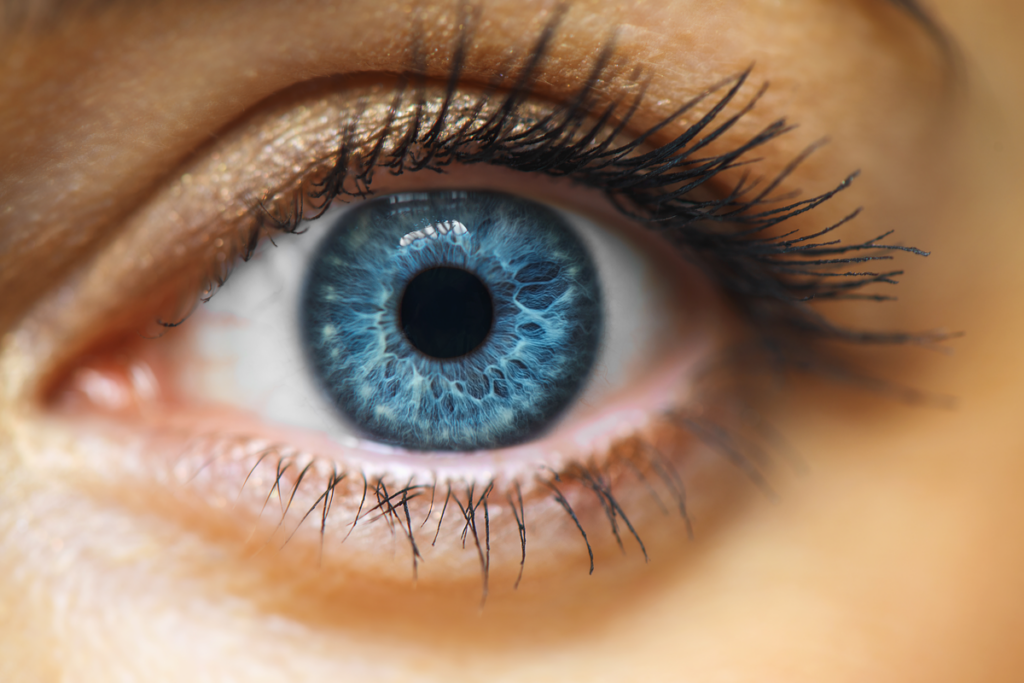Saccades of the Eyes: Characteristics and Functions

Human vision encompasses various processes. Saccades of the eyes are one example. They’re essential for the different activities that you carry out in your day-to-day routine. Furthermore, they can sometimes be related to certain disorders.
Most parts of your body play fascinating roles. For example, have you ever wondered what the mechanisms are that you use to pay attention when you talk to a person and look at them at the same time? Those that allow you to read or observe something really carefully.
“The eyes are the point where soul and body mix.”
-Christian Friedrich Hebbel-
Eye saccades
Saccades or refixation saccades are fast and simultaneous eye movements that occur when you direct your gaze. They’re controlled by the cerebral cortex and the superior colliculus of your brain.
Saccades favor the rapid displacement of fixation from one point to another in your visual field. Therefore, thanks to them, you’re able to map the environments in which you find yourself. In fact, they make it easier for you to capture the images you see when quickly moving your gaze.
Saccades help you to capture details. For this reason, they need to be precise. In addition, they can be voluntary, involuntary, or induced. To understand them better, think about the movements you make with your head when you’re observing your surroundings. In fact, try to do this exercise while, at the same time becoming aware of the saccades of your eyes. In this way, you’ll better understand their function.

How do saccades of the eyes work?
According to Gutiérrez de Piñeres Botero, saccades occur due to their association with control. In fact, voluntary and induced saccades appear when a specific visual stimulus catches your attention or when you respond to an order. For example, if you’re prompted to look in a certain direction.
Voluntary movements are accompanied by pro-saccades and anti-saccades. The former help you to direct your gaze towards a new stimulus. The latter ensure that you look away. For instance, when you want to look someone in the eye to enforce attention from your non-verbal language.
Involuntary saccades manifest as an orientation reflex. This reflex occurs when a stimulus appears suddenly that’s outside the periphery of your visual field or when there’s a novel stimulus. In fact, they’re related to survival, as they help you detect if there are signs of danger.
These functions can be evidenced when you read or must follow something and pay attention to its details. For example, when reading for a long period of time, you need these movements to keep your eyes on the words. Alternatively, when you try to follow something with your eyes, like an insect, or when you want to study in detail a work of art.
Types of saccades of the eyes
The saccades of the eyes are classified according to their individual functions. There are four types:.
- Anti-saccadic. This is the movement you make when you move your eyes in the opposite direction to where the stimulus is.
- Predictive saccades. They help you follow trajectories and predict the behavior of what you’re observing. For example, when you’re looking at a car.
- Visually guided saccades. They occur when you need to capture what you see after the appearance of a stimulus in your visual field. Or, simply when you need to capture something.
- Memory-guided saccades. They occur when you move your eyes towards some point that you have in your memory, even though it’s not currently in your visual field.
Saccades of the eyes were studied by Louis Émil Javal. He was a Parisian physician interested in optical instruments and eye movements. He started to study saccades after observing them in an experiment in which people had to read silently.

What disorders are saccades of the eyes related to?
Saccades of the eyes can be related to certain reading problems. For example, dyslexia. When these eye movements fail, it means they don’t maintain for the required duration or they’re inaccurate.
This problem involves being unable to correctly identify a letter or understand the complete information. Children with dyslexia quite often compensate by shaking their heads, reading a line by following it with their finger, or skipping sentences in the text they’re reading. Research suggests that slower saccades are associated with dyslexia.
Attention deficit hyperactivity disorder (ADHD) is also associated with saccade deficiency. In this condition, errors occur due to anti-saccadic and visually guided movements. They tend to make it difficult for the eyes to remain aligned when looking at nearby objects.
On the other hand, these movements can also occur involuntarily, causing vision to be reduced by a constant erratic movement of the eyes. This is called nystagmus and means sufferers can’t see clearly or stare intently.
Every time you read, pay attention to an environment or attend to a conversation, you’re making use of the saccades of your eyes. In other words, they help you to connect with others, to understand the written word, and, above all, to survive.
Human vision encompasses various processes. Saccades of the eyes are one example. They’re essential for the different activities that you carry out in your day-to-day routine. Furthermore, they can sometimes be related to certain disorders.
Most parts of your body play fascinating roles. For example, have you ever wondered what the mechanisms are that you use to pay attention when you talk to a person and look at them at the same time? Those that allow you to read or observe something really carefully.
“The eyes are the point where soul and body mix.”
-Christian Friedrich Hebbel-
Eye saccades
Saccades or refixation saccades are fast and simultaneous eye movements that occur when you direct your gaze. They’re controlled by the cerebral cortex and the superior colliculus of your brain.
Saccades favor the rapid displacement of fixation from one point to another in your visual field. Therefore, thanks to them, you’re able to map the environments in which you find yourself. In fact, they make it easier for you to capture the images you see when quickly moving your gaze.
Saccades help you to capture details. For this reason, they need to be precise. In addition, they can be voluntary, involuntary, or induced. To understand them better, think about the movements you make with your head when you’re observing your surroundings. In fact, try to do this exercise while, at the same time becoming aware of the saccades of your eyes. In this way, you’ll better understand their function.

How do saccades of the eyes work?
According to Gutiérrez de Piñeres Botero, saccades occur due to their association with control. In fact, voluntary and induced saccades appear when a specific visual stimulus catches your attention or when you respond to an order. For example, if you’re prompted to look in a certain direction.
Voluntary movements are accompanied by pro-saccades and anti-saccades. The former help you to direct your gaze towards a new stimulus. The latter ensure that you look away. For instance, when you want to look someone in the eye to enforce attention from your non-verbal language.
Involuntary saccades manifest as an orientation reflex. This reflex occurs when a stimulus appears suddenly that’s outside the periphery of your visual field or when there’s a novel stimulus. In fact, they’re related to survival, as they help you detect if there are signs of danger.
These functions can be evidenced when you read or must follow something and pay attention to its details. For example, when reading for a long period of time, you need these movements to keep your eyes on the words. Alternatively, when you try to follow something with your eyes, like an insect, or when you want to study in detail a work of art.
Types of saccades of the eyes
The saccades of the eyes are classified according to their individual functions. There are four types:.
- Anti-saccadic. This is the movement you make when you move your eyes in the opposite direction to where the stimulus is.
- Predictive saccades. They help you follow trajectories and predict the behavior of what you’re observing. For example, when you’re looking at a car.
- Visually guided saccades. They occur when you need to capture what you see after the appearance of a stimulus in your visual field. Or, simply when you need to capture something.
- Memory-guided saccades. They occur when you move your eyes towards some point that you have in your memory, even though it’s not currently in your visual field.
Saccades of the eyes were studied by Louis Émil Javal. He was a Parisian physician interested in optical instruments and eye movements. He started to study saccades after observing them in an experiment in which people had to read silently.

What disorders are saccades of the eyes related to?
Saccades of the eyes can be related to certain reading problems. For example, dyslexia. When these eye movements fail, it means they don’t maintain for the required duration or they’re inaccurate.
This problem involves being unable to correctly identify a letter or understand the complete information. Children with dyslexia quite often compensate by shaking their heads, reading a line by following it with their finger, or skipping sentences in the text they’re reading. Research suggests that slower saccades are associated with dyslexia.
Attention deficit hyperactivity disorder (ADHD) is also associated with saccade deficiency. In this condition, errors occur due to anti-saccadic and visually guided movements. They tend to make it difficult for the eyes to remain aligned when looking at nearby objects.
On the other hand, these movements can also occur involuntarily, causing vision to be reduced by a constant erratic movement of the eyes. This is called nystagmus and means sufferers can’t see clearly or stare intently.
Every time you read, pay attention to an environment or attend to a conversation, you’re making use of the saccades of your eyes. In other words, they help you to connect with others, to understand the written word, and, above all, to survive.
All cited sources were thoroughly reviewed by our team to ensure their quality, reliability, currency, and validity. The bibliography of this article was considered reliable and of academic or scientific accuracy.
- Coronel, R. (2018). Relación entre los movimientos sacádicos, lateralidad y proceso lector. Espirales Revista Multidisciplinaria de investigación, 2(7). Disponible en: https://acortar.link/SBh6oE
- Botero, C. (2019) Visión humana y movimientos oculares. Registro de movimientos oculares con el eye tracker Mobile eye XG. Universidad Católica de Colombia.
- Supèr, H. & Cañete, J. (2016). Hacia un diagnóstico más objetivo del TDAH: el papel de la vergencia ocular. Revista de psiquiatría infanto-juvenil, 33(3), 397-406.
This text is provided for informational purposes only and does not replace consultation with a professional. If in doubt, consult your specialist.







